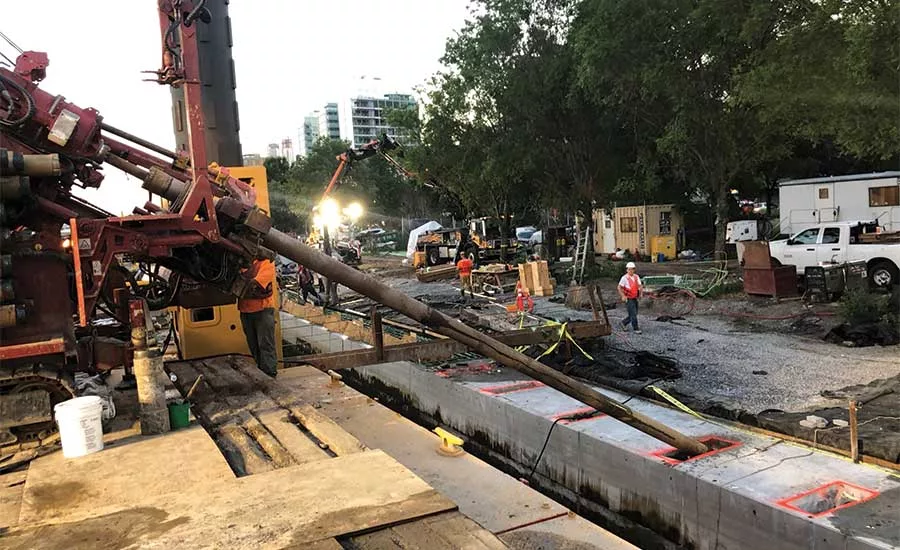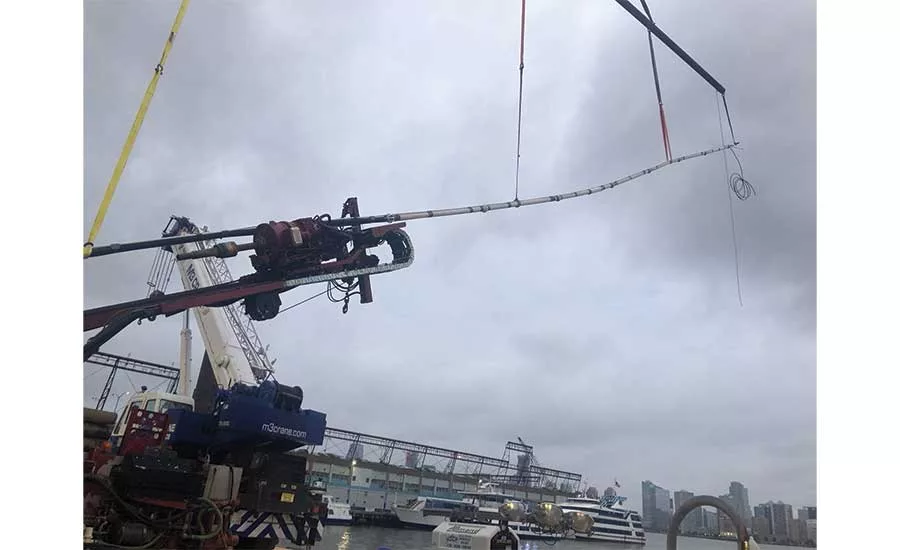Tieback Project a Job for Sonic Drilling

The sonic rig was set up to drill at 30 degrees on this Manhattan tieback project.
Source: Cascade photos

Aquifer Drilling & Testing Inc. (ADT), a subsidiary of Cascade, takes to the water again! Specializing in over-water drilling, the team recently started on a project installing tiebacks via a barge located only a couple feet from the shoreline.
Used as part of new construction or for remediation, tieback anchors are a construction element that actively applies tensile forces to existing structures. Typically constructed out of strands of cable or reinforcing bar grouted into the soil, tiebacks always contain a bond breaker (unbounded length) in the first 10 to 15 feet to ensure the load is transferred deep enough into the soil and to provide an adequate amount of free stressing length. The unbounded length can be increased depending on the design requirements. Tiebacks are typically installed at 15 to 45 degrees below horizontal, and can be permanent or temporary depending on their application.
This project, Hudson River Park, Morton Street Bulkhead Restoration, is located on the west side of New York City (Manhattan), just north of the Chelsea Piers. The scope of work called for the placement of 48 117-foot-long tiebacks. ADT used sonic technology to drill 8-inch casing at an angle of 30 degrees, and the tieback was installed in the casing and grouted in place as the casing was removed.
Tieback Drilling
Once the rig was set up on its drilling location and mast angle checked, the team used sonic drilling to install the anchor holes. The sonic drill process started with the rig being set up on top of poly, which was wrapped up around the tracks to act as containment. A spoil pan/mud pan was also set over the drill location under the mast of the rig to contain any spoils that returned to the surface from the borehole while drilling.
Once the rig was set up, the driller advanced a 3- to 4-inch sampler with a steel/carbide bit (depending on the rig tooling) to 5 feet below surface. Before the sampler was removed, a 5- to 6-inch override casing with steel/carbide bit was installed over the sampler to an equal depth. The rig used vibration, rotation, and some water to reduce friction and clear cuttings. This kept the hole and prevented collapse. That process was repeated to the final depth of the boring.
Once the final depth was achieved, larger-diameter override casing (8-inch) was installed. All smaller diameter casings were removed so the tieback bar could be installed in the cased hole.
Thread Bar Installation
Each 2¼-inch thread bar anchor was supplied in 2-by-50-foot and 1-by-17-foot-long sections. After drilling was complete, anchor bar totaling 117 feet was installed in each cased hole with the support of a cherry picker on the barge deck. The anchor was suspended by an H beam with unequal length slings so that the positioning of the suspended bar matched the 30-degree angle. Once the installation was complete, the casing was removed as the hole was completed to surface with the grout building from the bottom up, using the grout pipe provided with the anchor bar arrangement.
Stressing and Testing Tiebacks
Tieback stressing was planned for four groups of 10 anchors and one group of six anchors. For each one of those groups, stressing would be applied by the following phases:
- Phase 1: After the stressing jack is in place and alignment load is applied, hold for one minute and apply stress up to 66 kips. Hold the load for another minute and stress again up to 131 kips. Lock-off the anchor at 131 kips, move to the next tieback and repeat the same steps. Once all the tiebacks of this group are locked-off at 131 kips, proceed to next phase.
- Phase 2: Starting in the first sequenced anchor, unload it and proceed with the full load test program, either performance test or proof test. As per contract documents, performance test will run over four tiebacks TBD on site. All the other tiebacks are to be proof-tested.
- Next Group: Once this group of tiebacks is completely stressed and tested, and the tiebacks meet the acceptance criteria, the process will start over for the next group of tiebacks.
Tieback projects are nothing new to the geo-construction industry. However, ADT brought an added value to this project with their over-water drilling and sonic experience. Historically, sonic technology was not used in these types of projects, but ADT was able to shorten project completion time due to the efficiency of sonic drilling. Their expertise and equipment accessibility in over-water drilling also enabled them to access drill points that would otherwise not be accessible. Over the years, ADT has performed numerous over-water drilling projects with conventional drilling techniques, and more recently, using sonic technology.
Looking for a reprint of this article?
From high-res PDFs to custom plaques, order your copy today!




